As we prepare for the Virtual Gathering, commencing on Monday, and engage once again via zoom rather than in person, we continue to reflect on the role and contribution of our place based centers. We know ourselves, and from the many guests that traditionally visit, there is a ‘transformational field’ that supports inner growth in these environments. However, the way we’ve been able to plan our travel has changed profoundly and uncertainty over the future remains. Will people feel safe to travel again? Have their priorities changed? How can we best support wellbeing, spiritual growth and activism that can have the greatest impact in these times? What are the elements that are supportive both on retreat and at home? Join us as we work together for the development of a more conscious and ecological world.
Building Spaces that Breathe:
A Designer and Meditator’s Reflections on Creating Transformational Atmosphere
By Armand Graham
You can meditate anywhere, but retreats are special: a pause from the everyday that nourishes body, mind and spirit. As a meditator, architectural designer, and co-founder of ATMOS, I enter retreat centers for my own spiritual growth and also to learn how spaces can support people to turn inward and gain insight. Having practiced meditation for many years, I’ve had the opportunity to explore this question at several retreat centers, such as the Garrison Institute, Insight Meditation Society, the Omega Institute, and others.
Being on retreat opens a spaciousness inside me. I can breathe more freely, and my senses are heightened—calm but alert. I notice how the built environment fosters this feeling, and over time, I’ve decoded the design principles that make it possible. They are at the core of my creative process.
At a time when most have not been able to travel and many are depleted as a result of the pandemic, place-based transformational centers of well-being are poised to matter more than ever to help people heal and transform from the emotional, physical and mental impact.
As travel continues to be challenging, it’s also important to consider how centers can deliver on their mission by supporting everyday mindful living. As a designer, I believe it’s critical to support people in creating their own peaceful and restorative spaces wherever they can. If they are working from home they should be able to retreat from home as well. While my focus in this piece is on retreat center design, the principles here are portable and can be used at many scales.
VALUES AND NATURE: FOUNDATIONAL CONCEPTS FOR RETREAT CENTERS
My experience and research have revealed two fundamental concepts that architecture and design must incorporate to be successful in creating transformational retreat centers: Values and Nature.
The values embodied by an institution or organization drive design. What is the essence of the center’s purpose? What kind of experience is being created? Core values guide the answers and hence the design.
As for nature, the goal is to respect the surroundings while creating a conversation between the built environment and nature. How do we blur the line between inside and outside? How do we design so we engage natural beauty—a mountainous landscape, or a desert? And what can we do as designers to ensure sustainability and support local ecologies? Even in urban environments, nature can be incorporated on rooftops, or by framing the sky or neighboring architecture through windows to remind retreatants of the great beyond. How can this support the interplay of inner listening and outer action in our daily practice?
With these foundational concepts in place, we can turn our attention to how the elements of design can be used to contribute to an atmosphere of well-being and possibility.
FIVE ELEMENTS OF DESIGN
To create transformational atmosphere in the built environment, at ATMOS we incorporate five key elements: Architecture, Light, Materials, Sound, and Art.
Let’s consider each one.
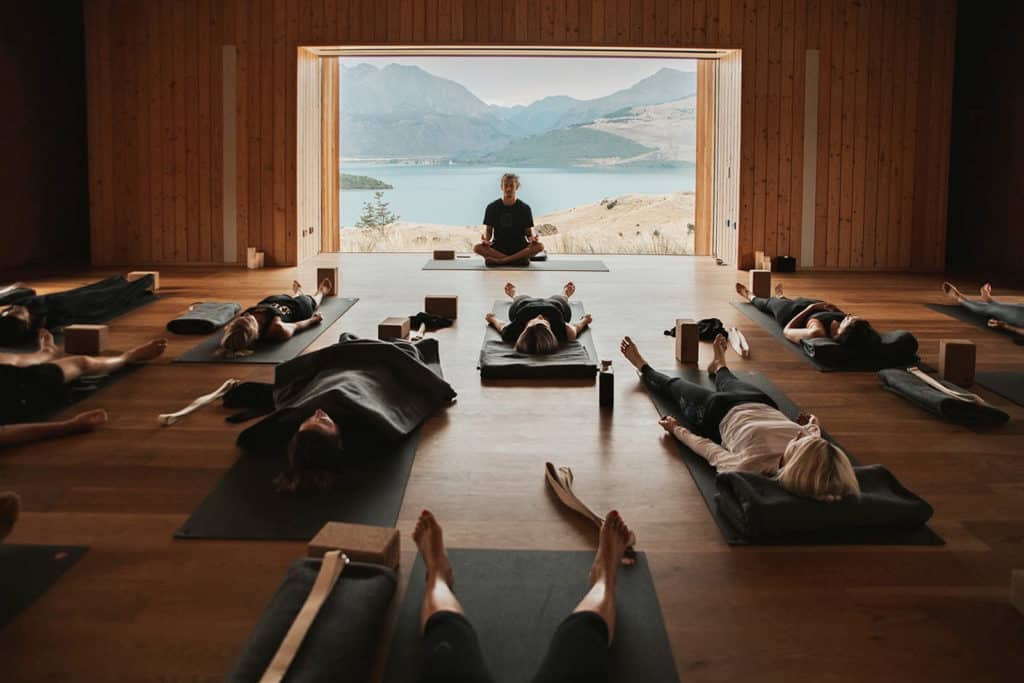
Tennent Brown Architects
Element 1: Architecture
Architecture can mean an actual building, or it can be an approach to shaping space to support the mission of personal and collective growth and transformation. Whether a room is square, round, tall, squat, open or subdivided will influence the experience of participants and the community.
At Cloud Mountain in Washington State, where I attended my first retreat years ago, the modest wooden structures of the main hall, dormitories, and bathrooms were nestled into the forest, covered with moss. The harmony of these buildings with nature invited me to find that sense of harmony within myself. I did, creating a lifelong practice of following my breath.
There is a rich architectural history looking at how space has an impact on physical and emotional well-being. Recently Evidence Based Design (EBD), defined as “the deliberate attempt to base design decisions on the best available research evidence” has emerged as a way architects and designers can make informed choices, especially for spaces meant to foster health and well-being. There is also the WELL Building Standard that “measures features of the built environment that impact human health and wellbeing, through air, water, nourishment, light, fitness, comfort, and mind.” These frameworks can help designers craft a healing environment to affect visitors like the humble paradise of Cloud Mountain affected me.
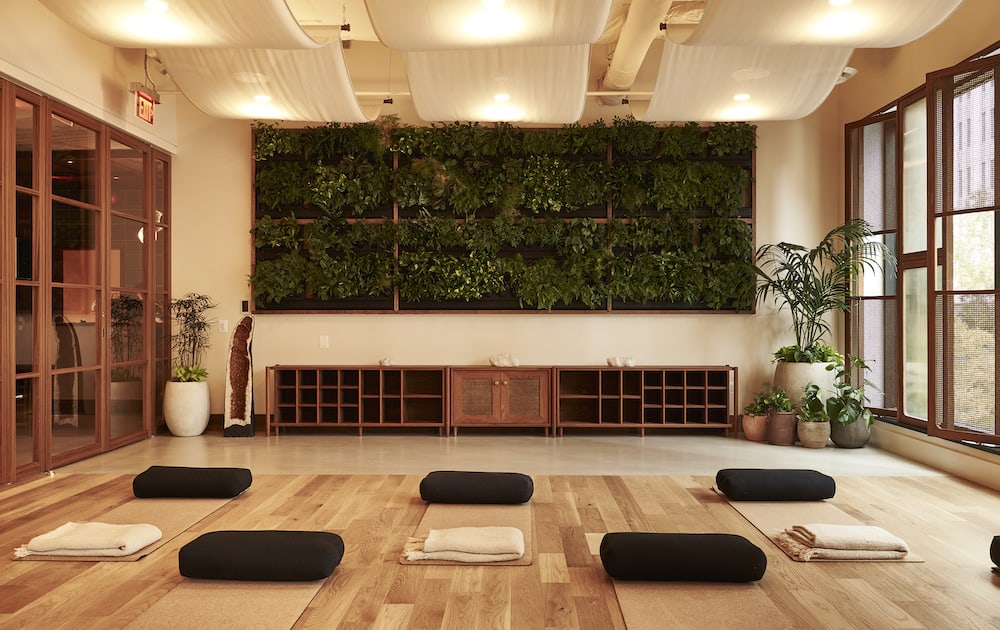
Parts and Labor Design
Photo Credit: Adrian Gaut
Element 2: Light
Light informs and influences everything we see. It sets the mood. Its warmth and glow can feed and heal the soul. Whether natural or man-made, how do we illuminate each space in a way that satisfies function and also elevates it?
For skillful lighting design, we begin by capturing daylight from dawn to dusk. How can natural light be used in each space throughout the day? How can artificial light simulate daylight in interior spaces? How can the experience of indoor spaces change because of the quality of light and shadow throughout the day? How can smart technology be used in designing a sustainable lighting system, and how can it include responsive technology and daylight harvesting to create the most natural lighting experience while also lowering the carbon footprint of the system?
A good example of the use of artificial light to create an understated and inviting mood is at the Won Dharma Center in Hudson Valley New York, where all the fixtures are hidden so the illumination is indirect and reflected. The strategy works particularly well in the main meditation hall, a glowing space where people sit for hours.
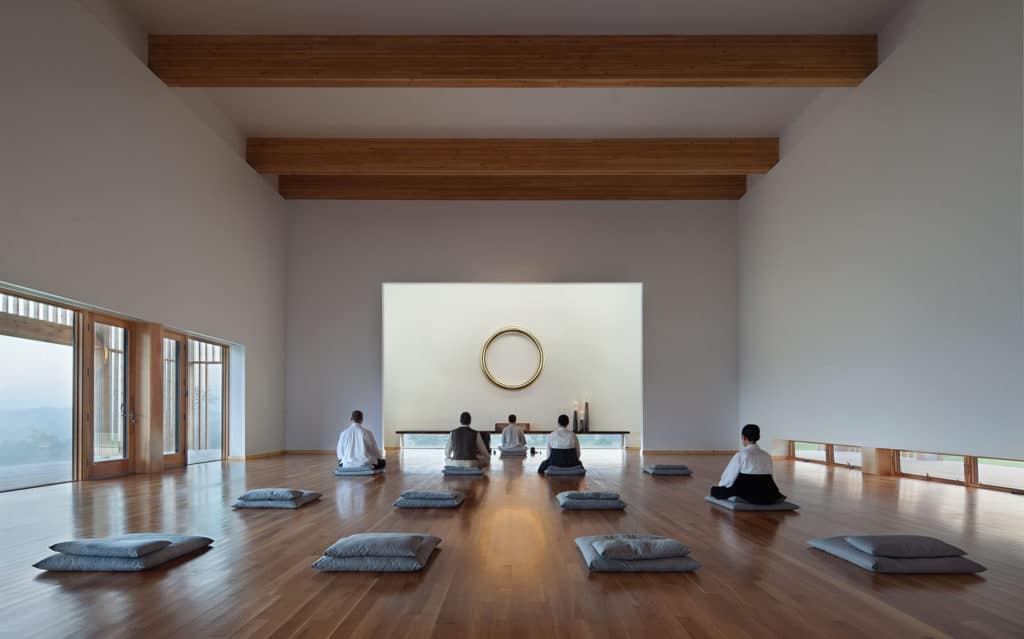
Hanrahan Meyers Architects
Photo Credit: Michael Moran
Element 3: Materials
Materials help define the feeling of a space through textures, hardness, luminescence, and tactility.
Materials range from hard to soft, smooth to textured, light to dark, warm to cold, vibrant to lifeless, patterned to plain, toxic to healthy, local to imported. They offer a full spectrum of color. The right palette of materials creates a sense of integrity, ease, and connectedness to the surroundings.
Combining natural and manufactured materials dramatically affects the atmosphere of a space. Walk with bare feet on wood floors, stone, or carpet—each experience is different. Each creates a feeling. Each has its place: the trick is figuring out where.
Craftsmanship is a quality people recognize. We feel when something is built with care and skill, especially when it is built by hand.
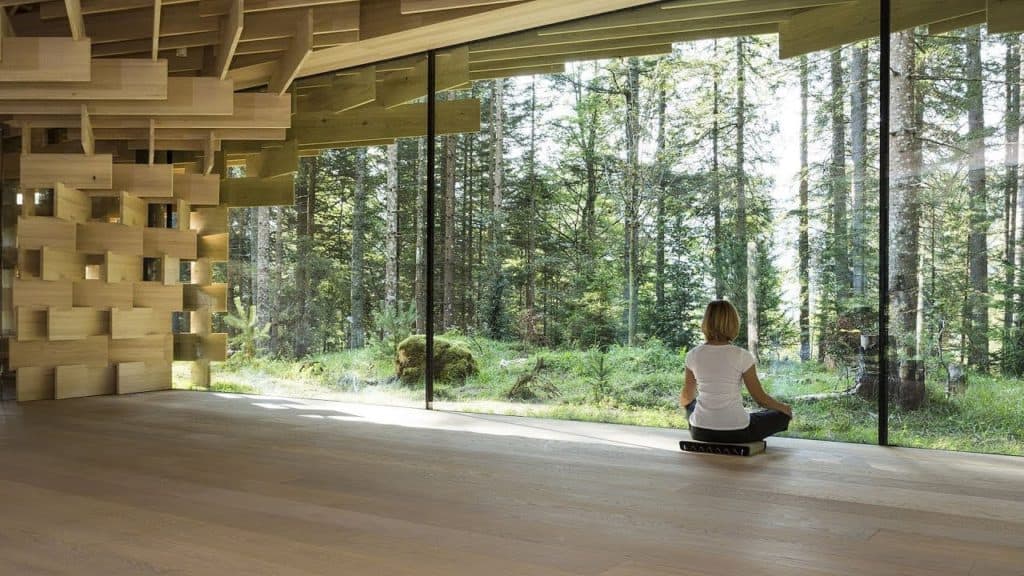
Kengo Kuma & Associates + STUDIO LOIS Architecture
Photo Credit: Erieta Attali
Element 4: Sound
Hearing is a sense gate that defines how we understand the world; sound plays an often undervalued but key role inexperience. Sounds can be comforting or distracting.
Curating the acoustic experience for a retreatant supports the inner journey. Silence is valued, but there is constant sound to manage through design.
Where can we allow the sounds of nature to enter? What materials can we use to soften or amplify sound? What sound systems best support teaching, ambient sounds, or music? How can we mitigate heating/cooling ventilation noise? Simplicity and quiet on the surface often requires planning underneath.
At a retreat I attended at Insight Meditation Society in Barre, MA, one teacher had a particularly captivating voice. When I closed my eyes, the clear sound system made it feel like he was speaking directly to me. During a guided loving-kindness meditation, I was having trouble connecting to my heart. The sonic intimacy transformed the moment. Quality sound is a subtle intervention but such an important one.
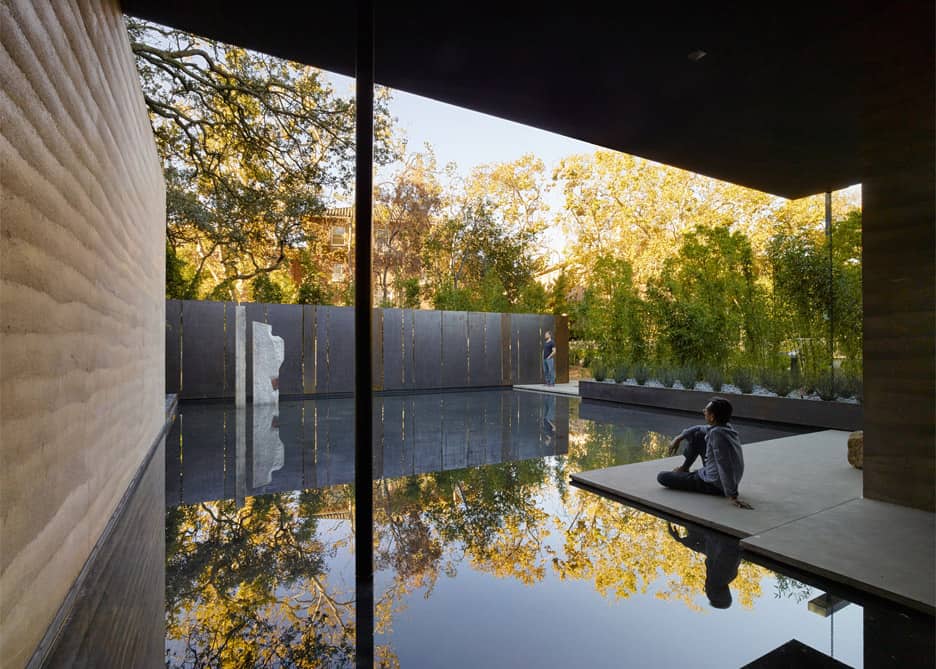
Aidlin Darling Design
Photo Credit: Matthew Millman
Element 5: Art
Aaron Yassin, my ATMOS co-founder, is an artist. He brings that perspective to the design process and feels there are three ways that art weaves the other design elements together.
First, a contemplative painting or sculpture creates a mood or feeling that defines a space. A program for art and artifacts plays an important role in expressing the values of a center.
Second, architecture itself can be art, leading to an emotional feeling and elevated perception. The designer achieves this by defining the relationships or qualities of proportion, mass, volume, materials, how light is controlled, how sound resonates, and how nature is framed.
Third, when a space is designed with just the right atmosphere it can generate the opportunity to have a grounding experience, one that may be characterized by looking, thinking and being present and aware. In this way, time spent at a retreat center, from beginning to end, can itself become a work of art as one learns and grows and expands in consciousness.
Retreats are a revitalizing pause from the everyday and by skillfully combining the five elements of design, retreat centers can create environments that facilitate transformational experiences and enable participants to find more harmony within themselves. That’s what they’ve done for me.
After more than a year of COVID-related confinement a retreat can provide much needed spaciousness and peace, but these transformational experiences need to extend beyond the walls of centers and into people’s lives. For those who cannot travel, one way to bring the atmosphere of retreat into the everyday is through attention to the elements I mentioned: the play of light in a room, the view of a tree, the stillness of a rock, ways to build even a small sacred space for daily practice. Ultimately, the power of the retreat lies in what we carry home with us. I believe that as we emerge from COVID, finding those spaces in our world and in ourselves is more important than ever.
—
Armand Graham is an architectural designer and Co-Founder of ATMOS, an Architecture + Design practice dedicated to building atmosphere.
armand@atmosdesign.com
www.atmosdesign.com
A fascinating and timely analysis , when we are looking to what sets holistic centres apart from ordinary places – and , in some cases , have an opportunity to reflect on these principles and to rebuild better. Inspiring examples too – I’d like to go and experience these places!
Thanks so much Christine for sharing this. The contents of this beautiful article resonate with the form and spirit of the architectural design of Vishva Niketan. Architectural design of holistic centres creates a cradle to soothe and calm our beginners mind.